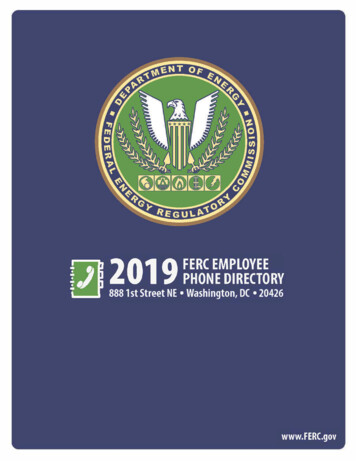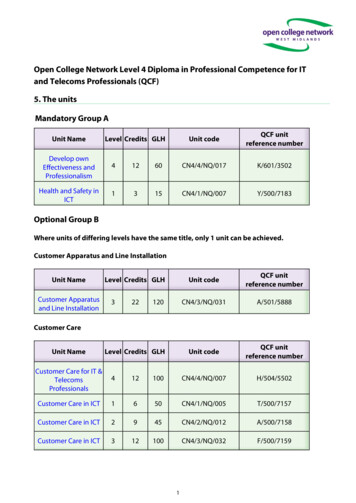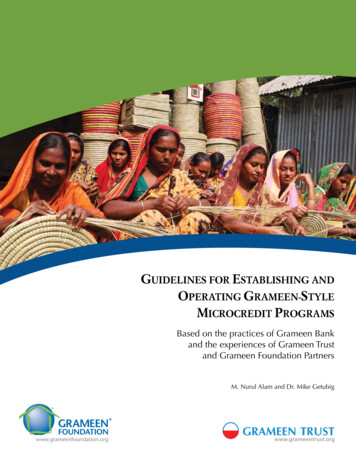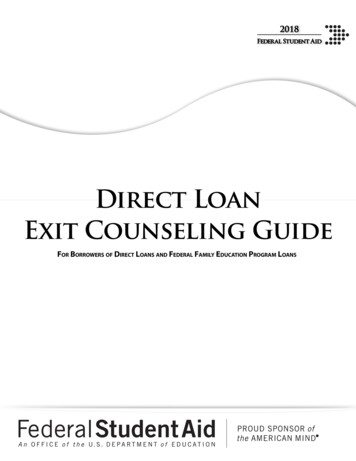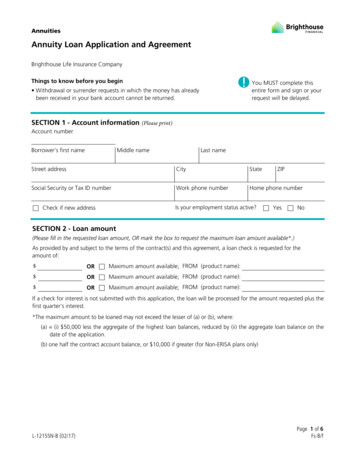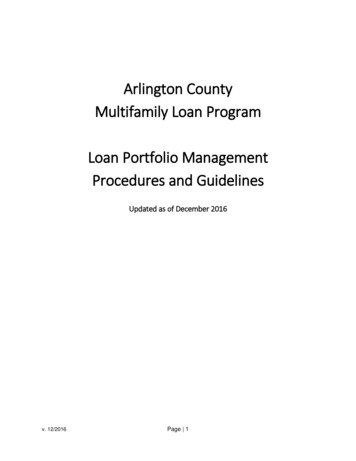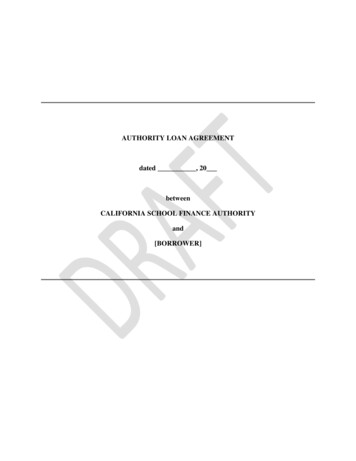
Transcription
Avoid Foreclosure:Pre‐Foreclosure Sale & Deed In Lieu to the Rescue!Section 502 Guarantee Loan ProgramWelcome to “Avoid Foreclosure: Pre‐Foreclosure and Deed in Lieu to the Rescue!This presentation will review more effective ways to leverage the pre‐foreclosure and deedin lieu loss mitigation options to help more USDA guaranteed loan borrowers avoidforeclosure!1
SFH GuaranteedCOST OF FORECLOSURESurvey of FY 2017 paid claims Average loss claim: 50,990 Average liquidation costs: 6,168Foreclosure is certainly not cost effective. Not for the borrower. Not for the lender. Notfor the U.S. Government.In a review of over 11,600 loss claims paid due to foreclosure in calendar year 2017: The average loss claim was over 50,000 and Average liquidation costs per claim were over 6,000These figures include loss claims paid for properties sold while in REO, unsold but held inREO, and foreclosures completed through third parties.That’s a lot of money!2
SFH GuaranteedLOSS MITIGATION OPTION USE Loan Modification 49%Repayment Agreements 45%Pre‐Foreclosure Sales (Less than 1%)Deed In Lieu (Less than 1%)This chart represents over 14,700 lender approved loan servicing plans for calendar year2017. 7,166 were loan modifications and Special Loan Servicing modifications 6,623 were forbearance repayment agreements 805 are short sales, and only 121 are deed‐in‐lieu3
SFH GuaranteedCOULD FORECLOSUREBE AVOIDED?The big question we would like to answer is: Could foreclosure have been avoided?4
SFH GuaranteedEVIDENCE OF HOPE Less than 3,000 claims Not due to foreclosureThere is evidence that USDA’s loss mitigation strategies, when approved and executed, arehalting the breaks on foreclosure activity.In calendar year 2017, less than 3,000 loss claims were paid for non‐foreclosure losses.Let’s review two very successful loss mitigation options that may be utilized to assist moreguaranteed loan borrowers to avoid foreclosure!5
SFH GuaranteedLEVERAGE YOUR OPTIONS! Pre‐Foreclosure Sale Deed in LieuIt’s time to leverage the pre‐foreclosure sale and deed in lieu options to help decreaselarger losses that are paid through foreclosures.So how can we make that happen? Let’s look at each of these options to see where theremay be more opportunity to extend these less expensive loss mitigation options.6
SFH GuaranteedPre‐Foreclosure Sales:LESS THAN 1%?Missed Opportunities? Failed repayment plan Repair language confusingPre‐foreclosure sales or short sales are certainly viable options to pursue for eligibleborrowers, yet they were utilized for less than one percent as a loss mitigation strategy .Perhaps more borrowers are eligible than some may think! Borrowers who have failed to meet the requirements of an approved repayment plan orspecial forbearance agreement have demonstrated that they are unable to meet thesepayments. USDA would encourage servicers to consider a short sale of the property inorder to avoid foreclosure. USDA has heard feedback regarding the confusing language associated with requiredrepairs to the property that may lead a servicer to deny the borrower for a short sale.Today we hope to address these concerns and assure you that many repair scenarios arenot going to reduce your ability to offer a short sale to your borrowers.7
SFH GuaranteedDeed In Lieu:LESS THAN 1%? Short Sale falls apart Borrower in bankruptcy Failed repayment planA deed in lieu does not have to reserved for very specific borrowers or very specificmitigating circumstances.It is clear from the data we reviewed earlier for calendar year 2017, that approved lossmitigation options compared to loss claims paid due to foreclosure, indicate the deed inlieu option is woefully under utilized. It’s use also accounted for less than one percent ofloss mitigation options. Today we are hoping to clarify that the use of a deed in lieu isresponsible and acceptable.Some great examples of when a deed in lieu is certainly an eligible loss mitigation strategyinclude, but are not limited to: Short sales that never make it to the closing table. When a short sale has beenapproved, but it cannot close, the servicer may change the loss mitigation option to adeed in lieu. The borrower may continue to exit the property. The servicer maycontinue to work to close the short sale, or market the property to a new buyer. Borrower’s that are currently in bankruptcy or discharged from a bankruptcy presentwell documented income and repayment issues. If a deed in lieu is accepted by theborrowers, the servicer may be able to market the property in a more efficient andexpedient manner. Failed repayment plans indicate the borrower’s inability to continue to meet the8
mortgage payments. It can be a better option for the servicer, the borrower, and thegovernment to execute the deed in lieu in order to quickly secure title and beginmarketing the property for sale.8
SFH GuaranteedGOALS Empower Partners Encourage flexibility Document appropriatelyHave you ever reviewed a borrower’s current financial situation, mitigating circumstances,credit, and collateral and thought X would be a great option, but you do not think theguidelines allow for you to offer it to them?If so, that is PERFECT! The goals for this training are to: Empower our servicing partners to more effectively leverage available loss mitigationoptions. Encourage flexibility! When a loss mitigation solution makes sense, USDA wants you topursue it and assist all parties involved. And finally, Encourage documentation! It is very important to always document your decisions,explain your assessment of the file, and why you chose the specific loss mitigationoption as the best solution for all parties.9
SFH GuaranteedWith these goals in mind, let’s all work together to help more borrowers avoid foreclosurethrough the analysis of provided servicing scenarios!10
SFH GuaranteedRegulation and Handbook7 CFR 3555:3555.305 Voluntary LiquidationHB‐1‐3555: Chapter 18Attachment 18‐A: Loss Mitigation GuideThe information that will covered today is available in the program regulation, 7 CFR 3555,Section 3555.305 for “Voluntary Liquidation,” and technical Handbook (HB‐1‐3555) Chapter18, Attachment 18‐A “Loss Mitigation Guide.”11
SFH GuaranteedUSDA Regulations and ulations‐guidelines/handbooks#hb13555These resources are available online from the USDA Regulations and Guidelines websitefrom the link provided.HB‐1‐3555 is listed by Chapter. 7 CFR 3555 is available as “Appendix 1.”12
SFH GuaranteedAPPLIED ASSUMPTIONS Waterfalls are exhausted1.2.3.4.5.6.Informal Repayment AgreementSpecial ForbearanceLoan ModificationSpecial Loan ServicingPre‐Foreclosure SaleDeed‐In‐LieuSpecial Relief Options:1. Extended term and lower interestrate2. Extended term, lower interestrate, and Mortgage RecoveryAdvance (MRA)3. MRA aloneAs we work through the servicing scenarios we are assuming that the applicable waterfallshave been exhausted including special relief options as applicable.13
SFH GuaranteedLEARNING CHECKS:START YOUR ENGINES!So start your engines and let’s get moving through some learning checks!14
SFH GuaranteedQuestion 1: True or False Borrower is discharged from Chapter 7 bankruptcy Mortgage debt is not reaffirmedLender must pursue PFS before a foreclosure may be initiated.Question 1: The borrower has been discharged from a Chapter 7 bankruptcy. They have not reaffirmed the mortgage debt. The lender must pursue a pre‐foreclosure sale before they can initiate a foreclosure. True or False?15
SFH GuaranteedQuestion 1: FALSEOffer a Deed in Lieu (DIL)! Borrower is no longer liable for the mortgage debt No financial package is required: recent BK Save foreclosure/acquisition costs Title must be clearAnswer: False!The lender could offer a deed in lieu! The borrower is no longer liable for the mortgage debt, as it has been dischargedthrough the Chapter 7 bankruptcy. The servicer does not need a new financial package. They were just discharged from aChapter 7 bankruptcy, so it is acceptable to work from this recent incident and anyprevious financials they may have. The deed in lieu will assist the servicer to save on foreclosure and acquisition costs. The servicer must ensure the title is clear in order to proceed with the offer of the deedin lieu.16
SFH GuaranteedQuestion 2: True or False Borrower is 60 days delinquent Property appraised for 100,000 Required repairs: 10k floor coverings, 10k replace A/C and heating system, and 10k deck replacement 30k total Repairs due to borrower neglect, not eligible for a homeowners insurance claimRepairs exceed 10% of appraised value. A PFS or DIL is not an eligible option.Question 2: The borrower is 60 days delinquent. The lender has ordered an appraisal of the property to determine appropriate lossmitigation options. It has appraised for 100, 000. The appraiser has listed required repairs that include 10,000 to replace floor coverings, 10,000 to replace the air conditioning and heating system, and 10,000 to replace thedeck. Which totals 30,000. These repairs are due to borrower neglect or inability to afford normal homemaintenance. None of these qualify as homeowners insurance claims. Since the repairs exceed 10 percent of the appraised value, the lender cannot offer theborrower a pre‐foreclosure sale or deed in lieu.True or False?17
SFH GuaranteedQuestion 2: FalseThis property is eligible for a PFS or DIL. Property is in average to poor condition Repairs are not an insurable loss or eligible for reimbursement Lender may either 1. Offer PFS without repairs or 2. Offer DIL, complete repairs,market propertyEither option avoiding foreclosure and saving moneyAnswer: FalseThe property will remain eligible for a pre‐foreclosure and/or deed in lieu opportunity. The property is in average to poor condition, and The repairs are not an insurable loss or eligible for reimbursement as part of a futureloss claim submission .BUTThe servicer may continue to offer:1. A pre‐foreclosure sale option without making any of the stated repairs, or2. Offer a deed in lieu, repair the property, and then market it for sale.Either of these options will accomplish the goal to avoid foreclosure and save all partiesfrom massive costs/fees.18
SFH GuaranteedQuestion 3: True or False Borrower is 30 days delinquent Residence was vacated and rented due to job relocation and upsidedown equity Renters left after two years, borrower is unable to cover the currentmortgageBorrower is eligible for a PFS.Question 3: The borrower is 30 days delinquent. They relocated the home as a primary residence when they relocated due to a new job.They were unable to successfully sell the home because the market value is upsidedown. The dwelling was rented for two years, but they have now vacated the home. Theborrower is unable to pay the current mortgage, nor find new renters in a short amountof time. The borrower is eligible to be offered a pre‐foreclosure sale. True or False19
SFH GuaranteedQuestion 3: TrueThe borrower is eligible for a PFS. Reason to vacate the property and hardship is involuntary Capacity to repay is not supportedAnswer: TrueThe borrower is eligible for a pre‐foreclosure sale! They may not be currently residing in the home as a primary residence, but that doesnot disqualify them from being considered for a pre‐foreclosure sale. The reason they originally vacated the property was for an employment opportunity.Their inability to repay the current mortgage is considered a hardship and an involuntarycircumstance. They have no capacity to repay the current mortgage and all of their additional debts. Therefore there is sufficient evidence to document in order to support the pre‐foreclosure sale option.20
SFH GuaranteedQuestion 4: True or False Borrower was approved for a PFS Reason for default was involuntary No capacity to repay the mortgage Property has been on the market for 90 days, no offersBorrower is eligible for a DIL.Question: 4 A borrower was approved for a pre‐foreclosure sale. The reason for the default was determined to be involuntary, and they have no capacityto repay the mortgage. The property has been on the market for 90 days with no offers. The borrower is now eligible to be considered for a deed in lieu?True or False21
SFH GuaranteedQuestion 4: TrueThe borrower is eligible for a DIL. Borrower’s capacity to repay is unchanged No new financial package is required if there is no change in hardshipcircumstancesAnswer: True The borrower’s capacity to repay remains unchanged .they still cannot afford thehome. No new financial package is required to consider the borrower for the deed in lieubecause there has been no change in their hardship circumstances.22
SFH GuaranteedQuestion 5: True or False All borrowers to the mortgage are deceased The home is now held by the heirs of the estate Mortgage balance is 105,000 Appraised value is 98,500Lender must offer a PFS before a DIL could be considered.Question 5: All borrowers to the current mortgage loan are deceased. The home is currently held by the heirs of the estate. The current mortgage balance is 105,000. The current appraised value is 98,500. The lender must approve and attempt a pre‐foreclosure sale before a deed in lieu maybecome an option.True or False?23
SFH GuaranteedQuestion 5: FalseThe lender may offer the heirs a DIL. There is no equity in the home Title must be clear The DIL reduces the burden on the heirs Reduces financial costs to liquidate the propertyAnswer: False There is no equity in the home.The servicer must ensure the title is clear before the deed in lieu may be offered.The deed in lieu will effectively reduce the burden on the heirs.It will also reduce the financial costs to obtain title to the property and ultimatelyliquidate it.24
SFH GuaranteedQuestion 6: True or False Loan is DQ 30 days Loss of job 2 months ago Borrower was renovating the kitchen, fire occurred: Total damage: 45,000 Appraised value of dwelling: 215,000 Insurable lossLender must proceed to foreclosure due to damage.Question: 6 The loan is delinquent more than 30 days. The borrower suffered the loss of their employment two months ago. They were renovating their kitchen in order to prepare it for listing when a fire occurred.The total damage was 45,000. The current appraised value of the dwelling is 215,000. Fortunately, this is an insurable loss, however the lender must directly proceed toforeclosure of the home due to the damage.True of False25
SFH GuaranteedQuestion 6: FalseThe lender may offer the borrower a PFS. The damage is an insurable loss Lender must work with insurance company to repair Market property for 90 days If no sale after 90 days, proceed to DIL and continue to market propertyAnswer: FalseThe lender may offer the borrower a pre‐foreclosure sale. The damage is an insurable loss, so the servicer must work with their homeownersinsurance company to obtain reimbursement for the repair. The property can be marketed for 90 days. If there is no sale after 90 days, the lender may proceed to offer a deed in lieu, vacatethe occupants, and continue to market the property.26
SFH GuaranteedGoal: Avoid Foreclosure Reduce costs to lender and government Avoid lengthy litigation Encourage homeowner to leave peacefully, collateral intact Reduce personal/emotional loss Assist homeowner to maintain better credit: Avoid bankruptcyTo summarize: the ultimate goal presented to today is to assist USDA guaranteed loanborrowers to AVOID FORECLOSURE! By doing so: Lenders and the government will achieve reduced costs to obtain title and liquidate theproperty. Pre‐foreclosure and deed in lieu opportunities allow the homeowner to leave thedwelling peacefully. There is a greater chance the collateral will remain intact and in thebest condition possible. Pre‐foreclosure and deed in lieu options have the ability to reduce the personal andemotional loss of the home. Borrowers are able to leave the home on their own terms,without the burden of public notices and other tell tale publications of pendingforeclosure actions. These options can also be presented to the borrower as credit protective. If thehomeowner is able to successfully complete a pre‐foreclosure sale or deed the homeover and leave, their credit will not be as damaged as those that remain in the home tofile bankruptcy and potentially end up with a foreclosure as well. As we are all aware,these incidents can detour future homeownership opportunities for a minimum of threeto five years under lender underwriting guidelines.27
SFH Guaranteed1. Reason2. Prudence3. Good judgmentKnowing USDA’s desire to avoid foreclosure, we ask that you approach the assessment of aborrower’s current situation under a new Standard Operating Procedure:1. Reason: Their explanation will become part of your justification2. Prudence: It is not prudent to jump to a pre‐foreclosure sale or deed in lieu except inscenarios where they borrower truly does not qualify for any loss mitigationopportunities. But when the well is dry: it is much more prudent to offer these optionsrather than pursue a long and costly foreclosure.3. Good judgment: When you apply good judgement to your decisions, it will be reflectedin your efforts to assist the borrower, think outside of the box, and not be afraid topursue less costly loss mitigation options in an attempt to make this transition as easyand dignified as possible for the homeowner.28
SFH Guaranteed1. Document2.Document3.Document!The most important tip of all is to:DOCUMENT, DOCUMENT, and DOCUMENT!!For yourself, for USDA, and for any auditors that may come knocking, it is very importantthat these parties can pick up the servicing notes and follow the justification for the lossmitigation opportunities that were approved, executed, and ultimately concluded.29
SFH GuaranteedSpeaking of Document: USDA LINChttps://usdalinc.sc.egov.usda.gov/RHShome.do1. Enter servicing plans upon your approval.2. Do not wait until the borrower responds.3. USDA requires documentation of yourdecision.4. Failure to report unauthorized servicing.Speaking of documentation .Don’t forget to upload your approved servicing planselectronically into the USDA LINC “Loss Claim Administration” portal.1. Enter servicing plans when YOU approve them.2. You do not have to wait until the borrower responds or accepts your offer.3. USDA requires documentation of your approved decisions, regardless of the borrower’sacceptance.4. If you fail to upload your approved servicing plans, it may result in unauthorizedservicing. Missing service plans may impact a loss claim payment.All servicing lenders have been granted delegated authority to approve servicing options asof August 2016. Therefore USDA is not approving your plans, but we need thedocumentation to support portfolio performance and gauge the effectiveness of our lossmitigation guidelines and options.30
SFH GuaranteedUSDA LINC:Loss Claim AdministrationThe Lender Loss Claim Administration webpage allows you to access items related to: Adding a Loss Mitigation plan View a Loss Mitigation List Display uploaded documents, and Maintain Lender/Branch Representatives, so they may have access to these items foryour company31
SFH GuaranteedHelpful Tips Be Empowered! Put PFS and DIL options on the table Document decisions Low cost options are win/winA few parting tips! Be empowered! As long as you are making reasonable decisions that result in reducedoverall costs and time to liquidate, then you are on the right track! Put pre‐foreclosure sale and deed in lieu options on the table. Do not be afraid to utilizethem! DOCUMENT, DOCUMENT, and DOCUMENT you decisions. Good notes are a good friendin a time of need! Low cost loss mitigation options will always be in style. Every borrower and theirsituation is unique. When you can craft an eligible loss mitigation opportunity thatworks for you, the borrower, and USDA: it is a win/win!32
SFH GuaranteedResources: USDA he USDA LINC “Training and Resource Library” website has a lot of information availablefor not only Loss Mitigation, but also other topics for the origination, GuaranteedUnderwriting System (GUS), Electronic Status Reporting, and Loss Claim Administration.All of these trainings and resources are available 24 hours a day!You can use the “bread crumbs” at the top of the webpage to quickly access the section ofthis website where your topic is located.33
SFH GuaranteedResources: USDA LINCThis is an example of the Loss Claim Administration and Servicing, Loss Mitigation, andProperty Disposition sections of the Training and Resource Library website.34
SFH GuaranteedResources: GovDeliveryPlease sign up for GovDelivery messages. These are email notifications of program updatesthat USDA will send as necessary.On the USDA LINC Training and Resource Library website, please click on the maroon circlethat has the image of a letter on it. It is the third icon from the right.35
SFH GuaranteedResources: GovDeliverySubscriber PreferencesThis will take you to the GovDelivery webpage where you can select your “SubscriptionType” as “Email” or “SMS/Text Message.”Depending upon your selection, enter the required email address of phone number. Thenselect “Submit.”This will take you to a “Subscriber Preferences” webpage where you can select from anynumber of available USDA program updates. This includes the “Rural DevelopmentHousing Programs.” Under “SFH Guaranteed” there are options for “Origination” and“Servicing.” Please select as many options as you wish. You can unsubscribe and update atany time.36
SFH GuaranteedThank you very much for joining us today! We hope this presentation will help you to assistmore USDA guaranteed loan borrowers and avoid foreclosure!37
This will conclude this session. Thank you very much for your time!38
halting the breaks on foreclosure activity. In calendar year 2017, less than 3,000 loss claims were paid for non‐foreclosure losses. Let's review two very successful loss mitigation options that may be utilized to assist more guaranteed loan borrowers to avoid foreclosure! 5

